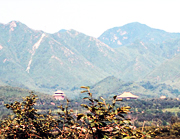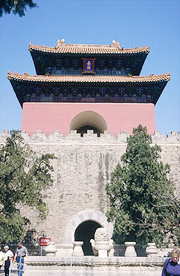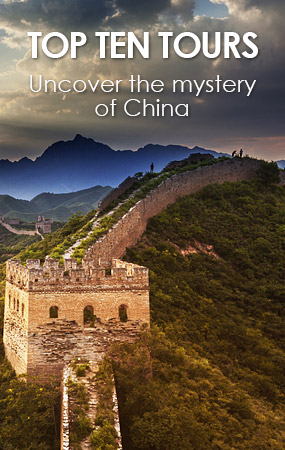The Site Chosen
Inscriptions on tortoise shells showed that the Chinese word for tombs had the same meaning with the word "nothing" which means buring underground and being void.
Confucius considered it necessary to earth up and build a tomb as a sign for the coming generations to pay tributes to their ancestors.  Since then tombs have been used for burial with their sizes differing according to their rank of the dead. The tomb of the emperor was the largest and most sumptuous. It was a mausoleum.
Since then tombs have been used for burial with their sizes differing according to their rank of the dead. The tomb of the emperor was the largest and most sumptuous. It was a mausoleum.
Although Beijing has been a capital city for five dynasties, the tombs of the Ming emperors are the only ones in the modern Beijing. The tombs of the Liao Dynasty (916-1125) are in north eastern China, and those of the Qing emperors (1644-1911) are 125 Km away from Beijing.  The Tombs of the Jin emperors were destroyed at the end of the Ming Dynasty. The tombs of the Yuan emperors didn't survive either.
The Tombs of the Jin emperors were destroyed at the end of the Ming Dynasty. The tombs of the Yuan emperors didn't survive either.
Yuan emperors didn't have any mausolemns. The reason was quite simple: Yuan Emperors were all nomads from the Mongolian Steppe. They held the belief that they should return to earth after death, because earth was where they had come from. They simply placed the dead inside a hollowed Nanmu tree, which was then buried under the grassland soon it would be difficult to find any traces of the tomb.
The Ming Emperors were Han Chinese who believed in the existance of an after-world, where the dead would live a life similar to that of the living. Ming emperors had grand mausoleums built for themselves The mausoleums had become a big building which has a square walled city called Baochen in the front and a precious top called Baoding in the back.
The Mausoleum area is composed of 13 tombs for the Ming emperors, each of which was built between a hill and a stream. The site was chosen with the greatest care, taking the feng shui (heavenly wind and earthly water) into account.
Before moving the capital to Beijing, Ming Chengzu, Zhu Di, sent people  to Beijing to select proper site for mausoleum, they spent three years travelling around Beijing and through figuring out the intention of the emperor, considered that the small basin at the foot of Huang Tu Hill, 10 Km north of Changping Town, with an area of 40 square kilometre, was ideal site of geomantic omen.
to Beijing to select proper site for mausoleum, they spent three years travelling around Beijing and through figuring out the intention of the emperor, considered that the small basin at the foot of Huang Tu Hill, 10 Km north of Changping Town, with an area of 40 square kilometre, was ideal site of geomantic omen.
Zhu Di himself inspected the site, and found the place was broad in space, screened by hills, having deep clear water, slow flows, and thick earth. In the north lays the Juyongguan Pass and in the south is ChangpingCity. An army could be stationed here to guard the mausoleums and defend Beijing. The geomancers suggested that from geomantic point of view, the site was rare and ideal. Zhu Di was satisfied and ordered the construction of Mausoleum. He renamed Huang Tu Hill, the Hill of Heavenly Longevity.

